Hiking Vacation La Palma
A Volcanic Landscape with Greenhouses and Water Reservoirs
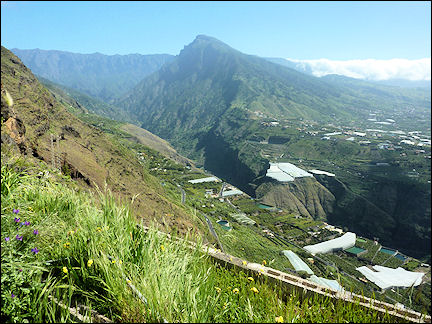
|
Hiking La Palma's many trails, it's immediately obvious how important fresh water is here: the volcanic landscape is covered with many water pipes and dotted with lots of water reservoirs. Santa Cruz de la Palma with its beautiful patios and Los Llanos de Aridane are visited, but the main activity is hiking around Tijarafe in the quiet western part of the island. Along gorges, plastic greenhouses and numerous observation points. Cactuses, palm trees, parrot's beaks and almond trees are blossoming.
Travelogue and photos: Kees van Tol
La Palma is one of the Canary Islands with few beaches and much natural beauty. If you don't like mountains and valleys, pick a flatter country, because there hardly is a square foot of level ground on this little Spanish volcanic island. It is located at a few hundreds of kilometers off the South Moroccan shore. One of its volcanoes erupted in 1971.
The Guanches were the original Berber inhabitants of La Palma. They called their island Benahoara. On La Palma the Guanches were therefore called Benahoares. Not much is known about them, except that they were white, were still around in the Stone Age and ate not only goats and sheep, but also dogs. These last gave the island group its name, not the canary. The Roman scholar Plinius the Elder used this name because of the large groups of dogs (canis is Latin for dog) that were found there.
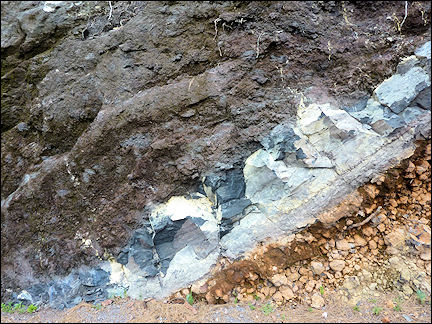
|
Between 1402 and 1496 La Palma was conquered by the Spanish Empire. Many Guanches were killed and others were sold into slavery. Colonists from the Mediterranean countries, Portugal and Flanders moved to the island to produce sugar, honey and wine. La Palma also became a tradepost on the route to the New World.
Hiking enthusiasts can walk to their hearts' delight on the heart- shaped island of La Palma nowadays, and likewise bikers who love hairpin turns will have a ball here. There are hiking trails everywhere, and the signs are usually adequate. There are no annoying dogs; there are dogs, but usually they are innocuous little barkers who stay on their own turf or old dogs who are scared of you, but still utter obligatory growls.
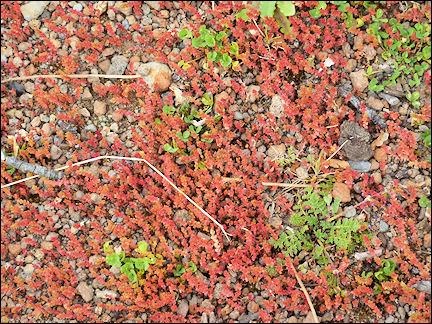
|
There are guided hikes every day of the week: a van picks you up at one of its stops and takes you to the starting point of the trail. You can of course use your own means of transportation to join the group of hikers.
The two of us are on the island in early March, to enjoy two weeks of sun. Our base is a white-plastered house just outside the village of Tijarafe on a slope with views of the Atlantic Ocean, where we see the sun set every evening. After sunset it soon gets too cold to sit outside, but during the daytime temperatures easily reach twenty degrees centigrade.
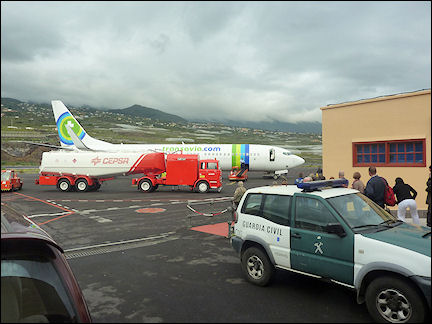
|
We mainly stay in the northwest of the island, exactly on the other side of the little airport with its runway that skirts the ocean. Compared to Schiphol Airport, the terminal is a tiny building. But construction to expand it is under way.
Santa Cruz de la Palma
Patios with pretty tiles and stairways
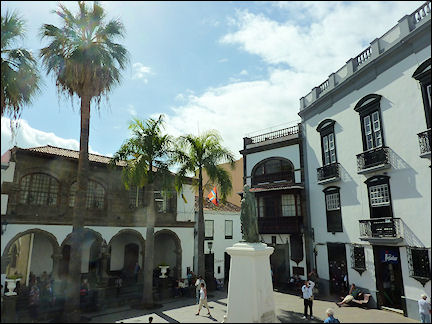
|
The small-scale airport is typical for the island in its entirety. The capital Santa Cruz de la Palma, which is in the eastern part of the island like the airport, is very compact. It lies by the sea and has a nice port. There are no large- scale tourist resorts.
The town has two shopping streets with clothing and trinkets; lots of tourists from other European countries are walking there. There also are street artists, lottery tickets sellers, market squares and outdoor cafés.
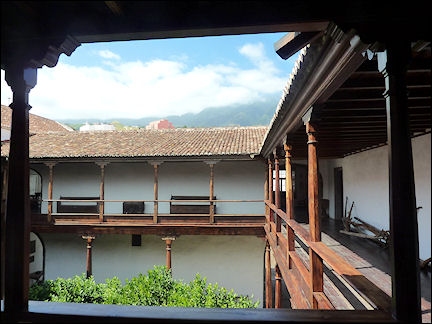
|
The church of El Salvador is worth seeing as is the pretty square in front of it. You should also visit the former Franciscan monastery on the Plaza de San Francisco, which currently houses the Island Museum.
It has a great variety of exhibitions: from farmers tools to stuffed animals; from modern art to priceless medieval Flemish masters and from musical string instruments to religious objects. A surprising diversity in a beautiful complex of buildings.
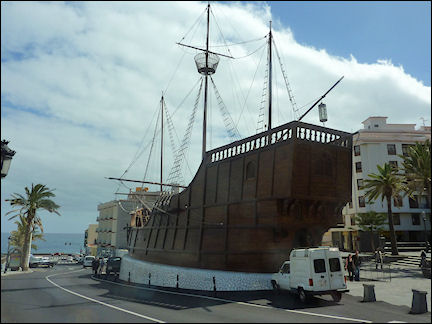
|
Santa Cruz (population 17,000) also has a maritime museum, which is housed in a wooden ship in a dry dock, not far away form a river without water. At least, while we are visiting, the river bed of the Barranca de las Nieves is completely dry.
At a higher lying spot in the town we find a 16th century church with a long name: Real Santuario de Nuestra Senora de las Nieves, or Royal Sanctuary of Our Lady of the Snow. She is the patron saint of the island. Apparently there is sometimes snow on La Palma, even though summer visitors will have a hard time believing that.
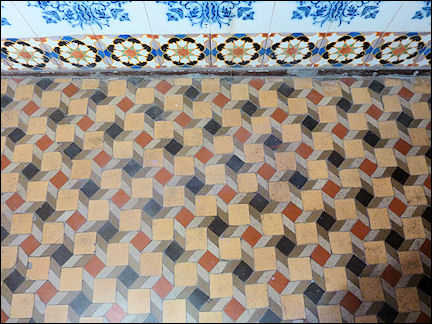
|
The houses and apartment buildings in the old part deserve special attention. Some have wonderful courtyards, with beautiful tiles and stairways. It's often possible to just walk inside. If not, you can admire them through the bars. Also the wooden balconies are worth taking a look at.
Santa Cruz has a lively promenade, the Avenida Maritima. Unfortunately there are rows and rows of parked cars between the road and the ocean, obstructing the view.
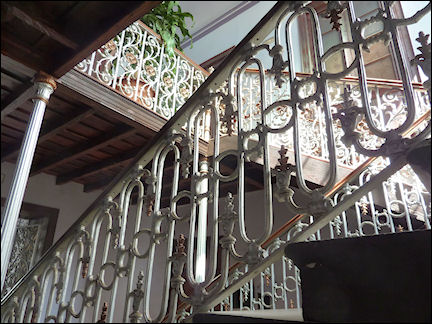
|
Fresh water is a problem on the Canary Islands, maybe that is why the Snow Mary was chosen to be La Palma's patron saint. There even are plans to move an iceberg from Greenland to the Spanish islands to alleviate the situation.
The lack of water is supposedly the worst on the more popular tourist islands like Lanzarote, Fuerteventura, Gran Canaria and of course Tenerife. On La Palma, which belongs to the three small islands, together with La Gomera and Hierro, I don't notice any lack of water, even though you become aware in many places that drinking water is not to be taken for granted.
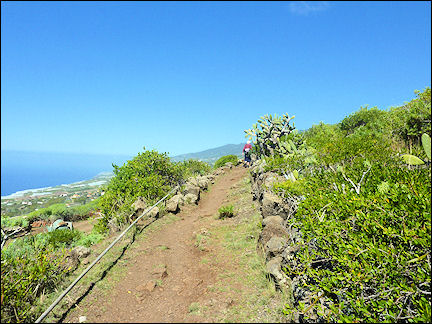
|
Everywhere along the narrow hiking trails are water pipes that transport the precious liquid from higher parts to lower parts of the island, or the other way around. There are as many water reservoirs here as there are mills and dykes in the lower lying parts of The Netherlands.
On the way from east to west, you find a visitors center outside El Paso which has information boards about the island. We see a wonderful French- spoken movie with images of the local flora and fauna and an animation about the way the island could have been formed in an era before there were humans. The island started as a series of volcanic pimples protruding from the ocean. The mountains on the island are (remains of) their craters.
There is a huge crater that offers spectacular panoramic views. We decide to leave this protected nature reserve, La Caldera de Taburiente, for a next visit. Part of the edge of the enormous crater collapsed a long time ago and now forms a long gorge: Aridane Valley.
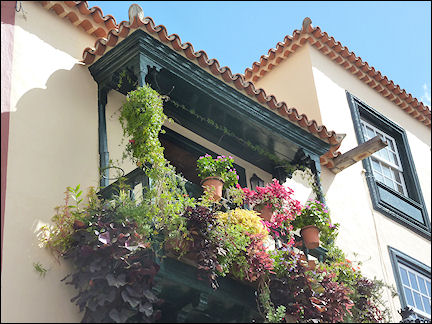
|
Driving on the main road from east to west, you have to clear this obstacle; the alternative is a long drive via the northside, with countless hairpin turns that suck the speed out of your car, a route that will take hours.
It takes half an hour to clear the gorge. Remember that Mirador el Time marks the end. Stopping there and looking back, you can see how challenging the hike was. The view is fascinating, also towards Tazacorte below us, where the sandy beach attracts quite a few tourists.
Don't assume the road will be straight and level from this point on: it still rises and falls and winds. In many places the views are stunning.
Tijarafe
Palm trees, cactuses and parrots beaks
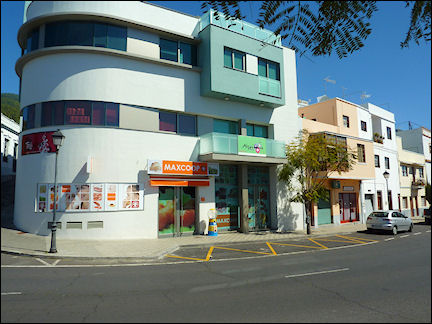
|
Our home base Tijarafe is a friendly, laid-back village (population 2,200) with some bars, restaurants, banks, a mansion which is used for exhibitions and a friendly house of prayer (church of Candelaria) on a likewise friendly square.
There are a large and a small supermarket and a few other stores. But there also is a health food store. These you see often on the island and signs like "Vollkornbrot" indicate that most tourists here are German. Someone told me that in a village on the northwest coast ten percent of the population were Germans, in 1996.
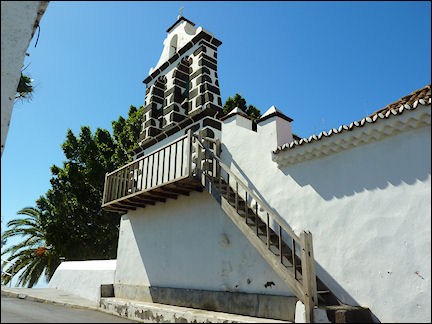
|
Agriculture is one of the main sources of income, especially avocados, almonds and bananas, which are small but tasty. In this area water has to be pumped up 500 meters to irrigate the produce.
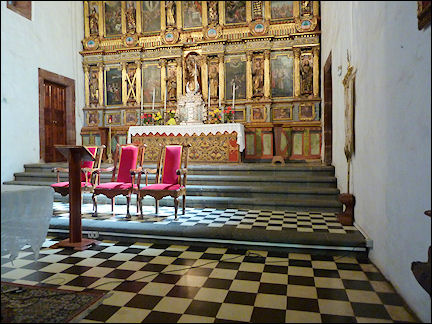
|
There are also palm trees, cactuses and flowers everywhere, some of which fill the air with sweet scents. In these last months of winter, the almond tree blossoms too, as do the parrots beaks.
Gilberto, who rents out vacation homes to us and others, treats us to a delicious Spanish meal, accompanied by generous amounts of drinks. First we have tortilla and the main dish is a tasty combination of sweet potatoes, pieces of whitefish, different kinds of vegetables and herbs.
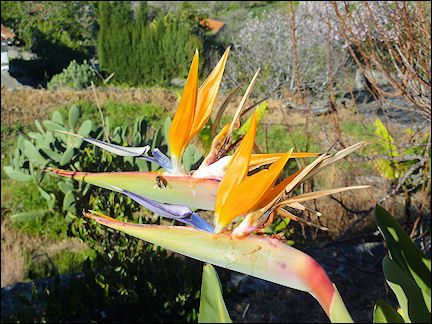
|
And all of this is free of charge: it's as if his reward is making his Dutch and German guests happy. He hardly speaks a word of any other language than Spanish, but still is a pleasant and charming host.
Los Llanos de Aridane
In some places the original character is preserved
We also visit Los Llanos de Aridane, the second largest town on La Isla Bonita.
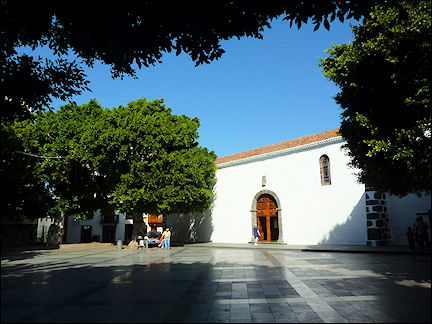
|
One of our travel guidebooks says that in some places the original character of this town is preserved. That is true; but sadly the places are few. The square in front of the church is pretty, with its unusual trees, the church itself is worth seeing, too, but the shopping area isn't and its cultural center is an ugly concrete building on grey pillars.
The indoor market with fresh produce and other articles of food is nice. Lots of parked cars here. Apparently Los Llanos has the most cars per inhabitant in all of Spain. Add to this the rental cars that most tourists drive and you'll understand that the parking garage (friendly prices) is not superfluous.
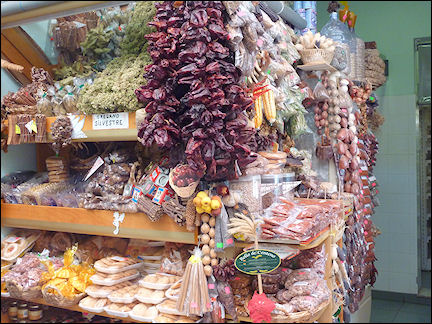
|
According to a German woman who lives here, public bus transportation is excellent. We see lots of buses on the island, so she's probably right.
On the way we buy food and drinks. Sometimes the cashier is on the phone with an acquaintance while she scans our groceries. As a streetwise urbanite, you assume it's lack of respect for the customer, but people here are simply less in a hurry than we are. Is that so bad?
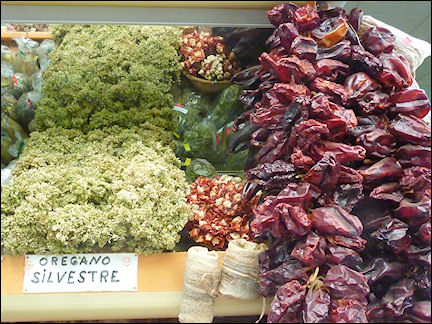
|
When you ask for directions, people are friendly and helpful. We didn't see any beggars. What we did see, were groups of civil servants successfully keeping streets and squares clean in villages.
The car rental representative was five minutes late, but men who were working for the competition put us at ease: she's on her way.
Hiking GR 130
Walking from gorge to gorge
La Palma has a vast network of hiking routes. Close by our vacation home in Tijarafe is the GR 130 wich takes you around the island, for a large part along the shore. This hike will take days, if not weeks.
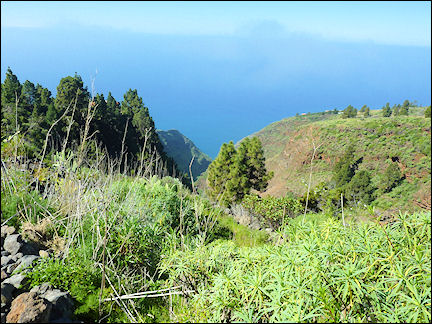
|
The route offers great panoramic views of the ocean over deep gorges and to the other side of over 2,000 meters high mountains. We walk a part of the route from Tijarafe northward to Mirador de Baranoje. This is one of the miradores (litterally: golden mirrors, but they are observation points) that can only be reached by foot. There are many of them along the route: recommended!
The route looks rather level on the map, but that turns out to be a misinterpretation. We climb and descent almost continuously. It's a hundred meters of steep climbing, then a leg of what looks level, but actually is slightly rising, and every now and then a level part and then we descend again.
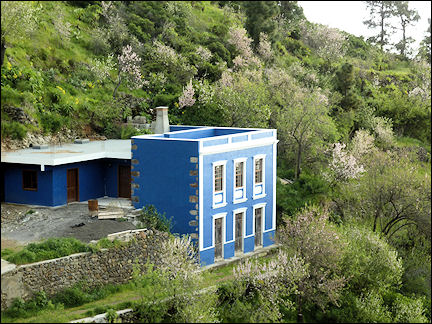
|
in this part of the long distance trail there are houses and farms everywhere; sometimes clustered together in hamlets like Casas de Tabladito, then again lone structures in the middle of nowhere. You find restaurants in villages, to which the trail meanders more or less regularly.
As everywhere in agrarian regions in southern Europe, there are many abandoned houses, often in the most beautiful spot. But there is also construction and renovation going on. The often bright colors of the houses are eye candy in and by themselves, like a bright blue house where people are busy renovating. We wonder how the trucks with building materials get there: the roads are extremely narrow.
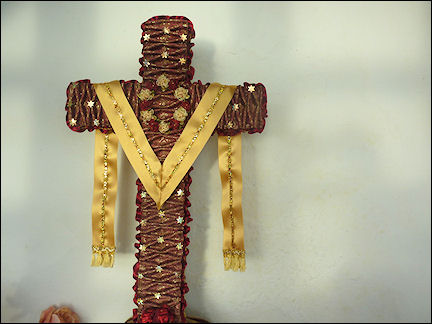
|
The crucifixes on the roads are typical for La Palma: wrapped in cloth and adorned with pretty ribbons, like the one at Cruz del Pinillo on our route.
This route takes you from gorge to gorge, skirting the edges, so it leads around the gorges. The paths are usually wide enough, so people who fear heights can walk on the 'safe' side. The few scary legs are short enough that most people with fear of heights will endure them.
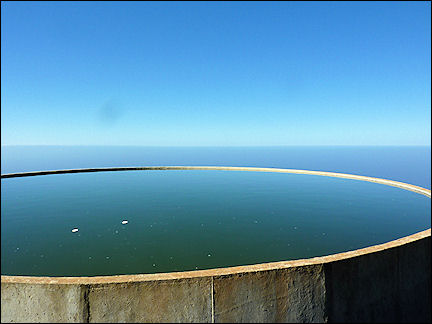
|
We take a rest at our final destination, Mirador de Baranoje. There even are two benches for hikers; an amenity that is mostly absent along the hiking trails of La Palma, but there always is a wall or tree trunk to sit on.
We enjoy the peace and quiet and the view of the deep, green valley of Barranco de la Baranda. Then we turn and a little later we are on an ever rising road, passing the quiet town of Casas la Castellana to the LP-1, the most important road in this area. We take a right onto this road. Luckily there isn't a lot of traffic. Every now and then the road has a diminutive shoulder.
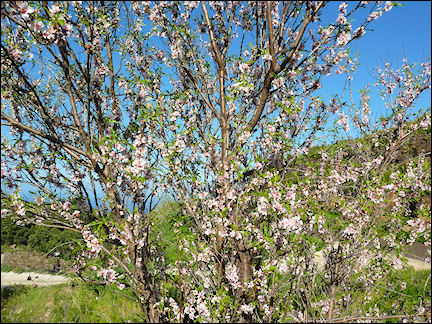
|
After only ten minutes or so we sit in a sunny outdoor café with views of the ocean and the valley we just left. The waiter is friendly and charges only 3.60 euro for two coffees and two bottles of cold mineral water from the island itself.
Then another short walk southward on the LP-1 until we turn right at Aguatavar, where we descend and find the GR 130 after a while.
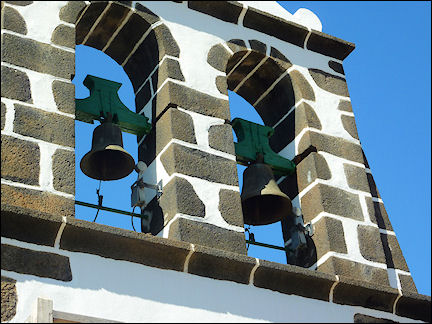
|
We use the Freytag & Berndt map (1:30,000) to plan our hikes. It helps a lot, but unfortunately it doesn't show every road on the island, so sometimes we don't know exactly where we are, which on the other hand makes hiking an adventure.
Hiking around Puntagorda
Descending to the ocean and plastic greenhouses
Our next hike takes us around the village of Puntagorda, a little to the north. We park the car near the church of San Mauro. Our destiny is the 500 years old church San Mauro Abad, which is indicated on the road signs. We just keep descending towards the blue ocean on a quiet asphalt road.
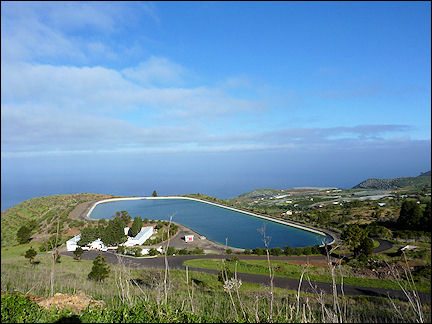
|
After a while we see a sky-blue water basin in the distance. As our descent continues, the water gets nearer. The slopes disorient our senses and it seems as if the water surface isn't level.
Next to the basin we find a walled cemetary. Two friendly cleaning ladies are just leaving when we arrive and everything looks squeaky clean. We read names and immerse ourselves in a world of cultural differences as we look at the - to our Dutch eyes - sometimes tacky grave decorations.
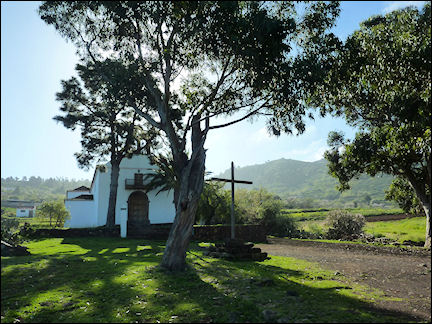
|
The old church San Mauro Abad is closed for renovation. That means we can't see the valuable statues inside. The white building sits on a quiet, unpaved square, not far from een ravine where the Barranco de San Mauro would flow if there had been more rain.
We rest undisturbed on the fancy stairs of a delapidated house that once probably was a prestigious rectory.
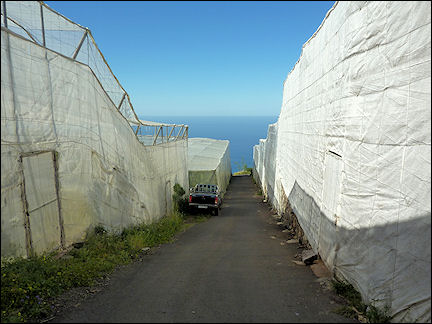
|
We walk on, for now on a more of less level stretch towards Mirador de Matos, which is located on the top of a 503 meters high hill. The top can only be reached on foot. Here, near the ocean, there are many plastic greenhouses, not really pretty, but fortunately there aren't as many as in The Netherlands' Westland.
We take a road back to El Pinar, a "suburb" of Puntagorda. The road back is long and steep. Climbing in the increasingly hot sun isn't easy. I plan to reverse the order of hikes: climbing in the morning when I'm still rested and descending on the way back.
Hike around La Punta
Mirador el Time looks on a large gorge
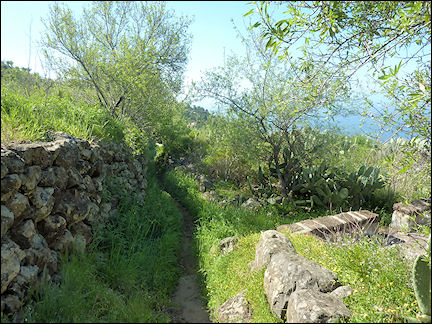
|
Our third walk starts just north of La Punta on the LP-1, some ten kilometers south of Tijarafe. We take a narrow asphalted road inland and up. Fortunately there are hardly any cars. At some point we automatically arrive at the long- distance route GR 131.
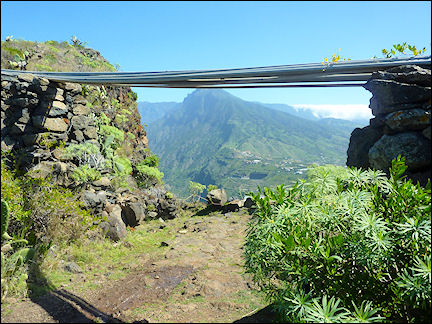
|
To the left the trail takes you along peaks on the large gorge to Roque de los Muchachas, with its 2,426 meters the highest peak on the island. On it sits an astronomic observatory; here, because the air is clean and there isn't much light pollution either.
There are also wide asphalted roads that lead to this spectacular part of the island. To our left is the Torre del Time, a peak popular with paragliders, who take a winged dive into the deep from here.
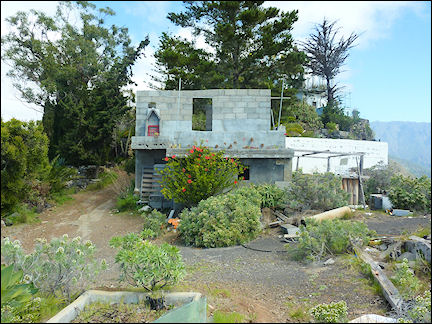
|
At the T-junction we go right towards Mirador el Time. The views along this route, with all kinds of narrow paths, are breathtaking. All of a sudden we find ourselves near a house with a garden, where a pioneer began to build a home with a spectacular view of the great gorge. Along the route stands a tall crucifix, its cloth wraps loosely waving in the wind.
There are a simple café and a tourist shop with lots of handcraft products in Mirador el Time. An excellent place for a break to look at the gorge between El Time and Los Llanos de Aridane on the other side. The latter is nearby as the crow flies, but to reach the town takes an impressive descent and then a winded climb.
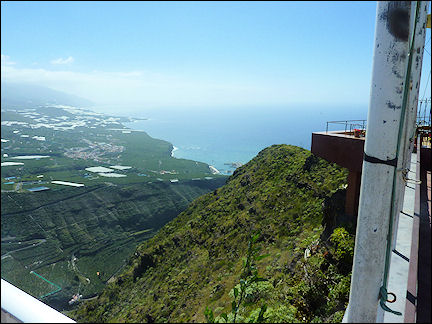
|
We return to our car at La Punta via a little leg back on the GR 131 and then left onto the GR 130. There are crystal clear signs everywhere. On this route, especially near Mirador El Time where lots of hikers start or finish, we meet between ten and twenty other hikers.
One is an English gentleman who enthusiastically tells us that there is a flower with a delicious scent about ten yards, eh, meters away. But in general you feel as if you are alone on the trails of La Palma.